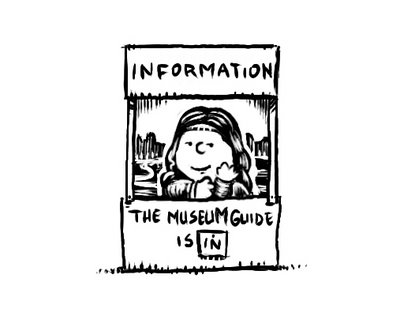
 Just what did Barnett Newman intend when he painted Be I back in 1970? How can we know what those intentions are, what his painting is supposedly about, if its meaning doesn’t immediately smack us in the face when we see it? Can we only consider some work a piece of Art if it doesn’t require us to read a novel to understand it?
Just what did Barnett Newman intend when he painted Be I back in 1970? How can we know what those intentions are, what his painting is supposedly about, if its meaning doesn’t immediately smack us in the face when we see it? Can we only consider some work a piece of Art if it doesn’t require us to read a novel to understand it?As I explained earlier, it doesn’t matter how far away a work is from reality that determines whether or not it’s Art. The distinction is blurry and wearing artsy reading glasses won’t help you see it any clearer. So when things become less clear we often need an explanation to help us along, because we can’t read the mind of the artist. Especially if he’s dead.
When I show you a painting like Cotopaxi by Frederic Church there is a certain amount of information that we can get out of it just by looking.
First, it’s got lots of nature in it and we like nature. Sunsets are beautiful and Church paints a really nice one that’s colorful due to the smoke and ash from the erupting volcano - a volcano, which we assume, that is the focus of the painting. But how do we know that the volcano is the focus? It does appear to be the most prominent feature of the painting, but it isn’t in the exact center. Plus it also shares the canvas with that sunset, as well as a nice waterfall with a rainbow, and a little fellow with his pet llama.
Any of those things could be the actual subject of the painting. So how are we to know? Luckily Church gave us a little bit of extra info. In this case, the title: Cotopaxi. And if we know anything about South American vulcanism we would know that Cotopaxi is not just the name of a painting, it’s also the name of a rather large volcano in the Andes. So it’s about the volcano after all!

Or is it?
Just how much information does the artist have to give us before we know what the painting’s about? As much as it takes apparently. Art is somewhat like a language, each work a different dialect. If we don’t understand the language we might need a translation to help us out. So if I’m speaking French to you and you only understand English, I need to tell you what I mean when I say, “Cotopaxi est le commentaire de Church sur la tragédie de la guerre civile américaine. “But just because you don’t understand what I’m saying doesn’t mean that French isn’t a language. Frederic Church does the same sort of translation work when he titles his painting Cotopaxi and tells us that it’s his commentary on the tragedy of the American Civil War. Now we understand. We may say he’s philosophizing, but that was his intention in painting his work of Art.
Likewise, Barnett Newman explains that Be I is about the existence of being. The red background represents earth and the white stripe, which he called a “zip”, suggests a moment in time. A flash. It may not be apparent at first viewing but now that we know we have a greater insight of what the artist meant to say. A greater insight into his interpretation of his universe. The more we study Art the more we can understand those artistic dialects. and we become the richer for this exchange of ideas.
If photographer Andres Serrano puts a cross into a vat of urine, photographs it, calls it Piss Christ, and then proceeds to give it meaning, that is his intent as the artist. So, believe it or not, that makes it Art.
You might not like it, but that doesn’t change his intentions. The same goes for a lime wedge I stick on a toothpick and call it my statement on the vitamin C intake of barflies. It just became Art. Just now. And it’s Art by our definition. But how are you supposed to react to it?
Next time: Function Junction




Does art require that the viewer research the artist's intent before looking at it? Is the artist's intented meaning of the piece the only valid interpretation of it?
ReplyDeleteDoes this make your head hurt too?
It's my belief that the art doesn't require anything from the viewer. Put as much or as little work into understanding art as you wish.
ReplyDeleteAs for your second question, hmmm...I guess my answer would be "depends".
The artist might want you to come up with your own interpretation. So in that case the answer would be "no".
But as I'll touch on later, we can never know exactly what the artist's intentions were anyway, so it doesn't really matter.
I guess any meaning you give it is valid to you, and for you that is all that matters. It's just my personal preference that when I'm studying a work of art I want to know as much as I can as to why he or she made it and what it means to them.